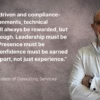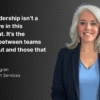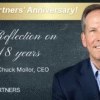
By Chuck (Charlie) Mollor, CEO, MCG Partners
Over the past two years our world has changed dramatically. The disruptions brought on by the COVID-19 pandemic have changed the way we work and live. They have forced businesses to regroup and rethink their products and services, strategies and, most of all, how to keep employees engaged and productive.
Dozens of studies, surveys and research since the beginning of the pandemic describe the seismic changes in the workplace. The shift to remote and hybrid working. Employees reexamining their priorities and taking a hard look at their work/life balance (a.k.a., the “Great Resignation,” or the “Great Reflection”). And millions of workers leaving the workplace altogether, causing an intense talent shortage.
The challenge for today’s leaders is to provide stability amid this constant change. A tall order. Stability, however, needs a framework and culture is that framework.
Start with the basics
For many organizations, the pandemic has caused profound changes in purpose and mission. Rather than ignore these pressures, leaders must confront them and reevaluate. Has your purpose changed? Do you need to modify your mission? Who do you now aspire to be?
Clarity around mission – especially in these times of constant change – is crucial. In a 2020 Gallup report, an astounding 60 percent of employees could not fully agree that they know what their companies stand for. The implications of this are staggering. How can employees execute their part of the mission, interacting with customers and completing essential tasks, for instance, if they don’t understand the big picture?
There must also be alignment between the external and internal brand. The external brand is easier to understand. This is who we are, why you should buy our products and services, what your experience will be like. Similarly, employees (and candidates) want to know why they should work for your company, what their experience will be like, why should they stay and build a career with you.
A strong culture, one that guides the ship in rough seas, needs a clear mission and purpose, aligning both the external and internal brand.
Values drive behavior
The next step is to translate your purpose, mission and brand into clear, understandable values. Culture isn’t some esoteric concept that is divorced from day-to-day life. On the contrary. By defining values and translating them into specific behaviors, you create structure. Then your HR systems and processes can support the ability to create your culture and maintain it. These behaviors drive how you hire, develop people, build teams, promote, reward and plan succession.
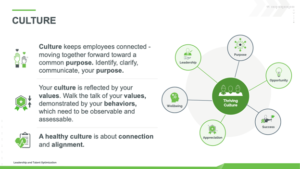
How to squash innovation
At the helm of the ship, of course, are your organization’s leaders. They are the ones defining culture by demonstrating those value-driven behaviors. They must be a role model, to recognize and reward the right behaviors and sustain the organization’s culture. But when they don’t “walk the talk,” that’s when employee engagement drops, and all those well-planned strategies fall apart.
Here’s an example of an organization trying to shift their mission and values. A leading electronics manufacturer needed to improve their products to stay competitive. The CEO recognized this. He decided that innovation was the key to accomplishing this. He wanted to integrate innovation as a value into the organization’s culture. And he seemed to do everything right to accomplish this. Value-driven behaviors were identified. An innovation organization leader was appointed. Innovation teams were formed. Roles and responsibilities were changed to emphasize innovation.
However, the CEO himself was risk averse. The moment there was failure, the moment it didn’t work as anticipated, not only was there a retaliatory response but there was an immediate “cease and desist” order. Innovation sounds great on slide decks. But the challenge in this organization was tolerating the mistakes that always accompany innovation.
Google conducted a study over a two-year period evaluating more than 180 teams. One of the five factors that determined a high performing team was psychological safety. If you want a culture of psychological safety to drive engagement, performance, innovation and change, you need a culture where people can challenge the status quo, disagree, have altering views. People need to feel valued, that it’s ok to make a mistake, to ask tough questions, raise concerns and ask for help.
The Agile Leader
To be agile, to shift mission, purpose and culture as needed, requires self-awareness. Managing change starts with the individual. Do you know yourself, the experiences that have shaped you, your behavioral self and strengths, and your values? As a leader, do you understand your strengths and shortcomings, and how they impact the organization? In the example above, the CEO failed to acknowledge his value system, deep inside him – he didn’t like failure, he wanted a sure thing the first time around. No matter what level of leader you are, this self-awareness is essential. Do you talk about delegation and supporting the growth of your direct reports – and then micromanage them? The key is to understand how you impact the things that you’re trying to accomplish. Leadership doesn’t only create the cultural framework that supports the organization’s mission, strategy and brand. Leaders must demonstrate those value-driven behaviors and be held accountable for sustaining culture.
Why is culture so important now?
We’ve been talking about the importance of culture for years. What’s different now? For one, younger generations are demanding that synergy between culture and organizational mission. Saying one thing but doing another isn’t cutting it. They place high value on diversity, equity and inclusion, for example. And they’re willing to leave the employer if they don’t see leaders walking the talk. We’re also in an incredibly tight labor market. Attracting the best talent is essential. Retention is essential. Employee engagement, therefore, is vital.
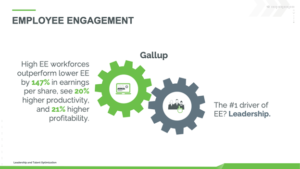
Source: https://www.gallup.com/workplace/317753/remote-work-virtual-threat-culture.aspx
The other shift is that leaders today are recognizing the importance of culture. In PWC’s 2021 Global Culture Survey, two-thirds of C-suite executives and board members said they believe culture is more important to performance than the organization’s strategy or operating model. Further, 69% of organizations that adapted amid the pandemic felt that culture gave them a competitive advantage. However, a worrying gap exists between management and employees. In the study, over three-quarters (77%) of senior management said they felt connected to the company’s purpose compared to only 54% for everyone else.
It all begins with a clearly defined and communicated culture, aligned with purpose, mission, brand and strategy. This leads to higher employee engagement and ultimately better business results. Culture, then, is the framework that can steady the ship.
-end-
Today’s complex, multi-generation workforce needs leaders who are agile, empowering, decisive, and lead from a place of trust, who understand individual motivations and can adjust their style. To learn more about being an Agile Leader, click here.

https://www.gallup.com/workplace/317753/remote-work-virtual-threat-culture.aspx
About MCG Partners
MCG Partners a woman-owned, Greater Boston-based consultancy specializing in executive coaching, leadership development, talent management, and organizational development solutions. We help businesses optimize success through the entire management life-cycle. MCG Partners is also a Predictive Index® (PI®) certified partner.
To learn more about MCG Partners’ services or The Predictive Index®, contact Stephanie Holmgren stephanie.holmgren@mcgpartners.com or at www.mcgpartners.com


